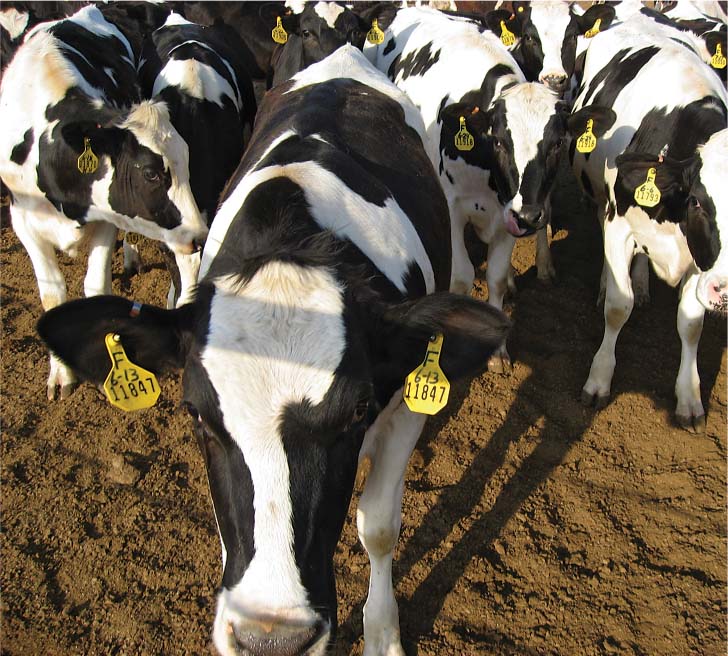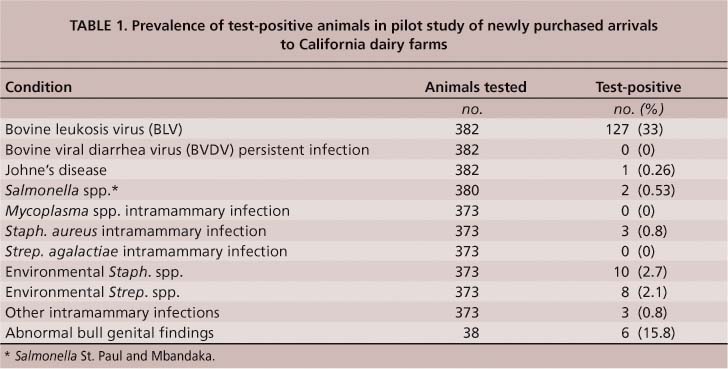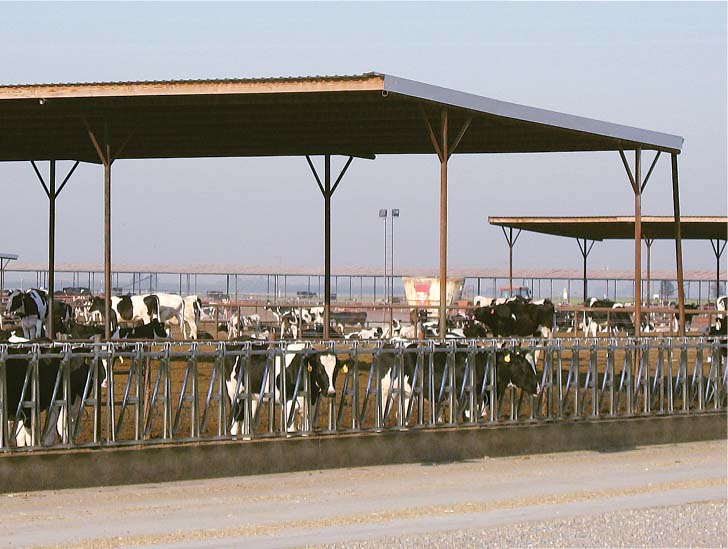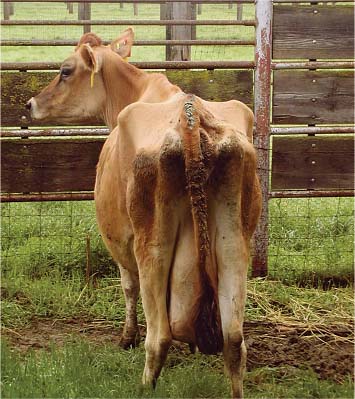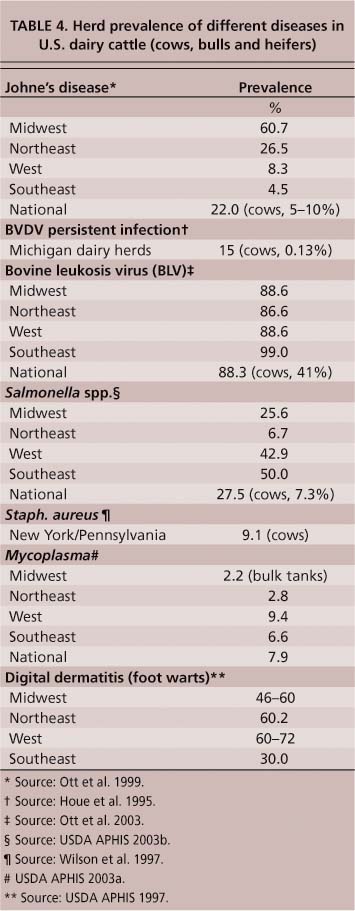All Issues
Testing new dairy cattle for disease can boost herd health, cut costs
Publication Information
California Agriculture 63(1):29-34. https://doi.org/10.3733/ca.v063n01p29
Published January 01, 2009
PDF | Citation | Permissions
Abstract
Dairy producers seldom test or examine incoming cattle, although these important biosecurity practices are recommended. This pilot project examined risk management decisions that producers make when faced with test-positive animals in purchased groups of dairy cattle, in order to provide information on disease risks and conditions that could affect animal health and performance. New arrivals to seven herds at dairy farms in four California counties were examined and tested for a range of conditions. The most common findings were bovine leukosis virus (33% of cattle purchased) and male reproductive abnormalities (16% of bulls purchased). Once testing results were known, producers made a variety of risk management decisions. Although testing costs for some conditions outweigh the benefits of finding an infected animal, an individual producer's decision to test new animals most likely depends on their knowledge of the pros and cons as well as their risk tolerance.
Full text
The farm is considered the front line of food system security, and bio-security practices such as disease testing are the primary means to protect the farm. Attention to on-farm bio-security for livestock has been spurred by current certification and eradication programs for Johne's disease and bovine viral diarrhea virus (BVDV), the foot-and-mouth-disease outbreak in British sheep and cattle in 2001, and the letter-borne anthrax bioterrorism attacks in 2001 (Sandvik 2004; Sockett 1996; US Senate 2006).
Every year, California milk producers import about 120,000 to 130,000 head of dairy cattle into the state, primarily heifers. Yet surveys have found that the vast majority of producers do not test incoming animals for economically important conditions and communicable diseases.
The dairy industry in the United States has not widely adopted biosecurity practices, particularly those related to purchased cattle. In Wisconsin, less than 50% of producers with recently purchased cattle asked about the herd of origin's disease status, and less than 20% did any testing of animals they purchased (Hoe and Ruegg 2006). In Idaho, 80% of herds undergoing expansion did not require health testing for new cattle, except for mastitis detection (Dalton et al. 2005a). In addition, only about 40% of producers purchasing bulls quarantined them on arrival and only about 25% required a breeding soundness examination (Dalton et al. 2005b). In the upper Midwest, nearly 60% of herds undergoing expansion obtained cattle with minimal health histories, and less than half required any health testing (Faust et al. 2001). Yet owners and managers involved in herd expansions indicated that herd health was compromised as a result of expansion. Similarly, Canadian farms that purchased replacement animals had more cattle testing positive for Johne's disease than farms that did not purchase animals (Chi et al. 2002).
There are approximately 1.7 million head of dairy cattle in California, which produced about 41 billion pounds of milk in 2007, generating an estimated $61.4 billion in economic activity in the state. The movement of dairy cattle into California is a risk to the state's herds. The state imports approximately 120,000 to 130,000 head of dairy cattle annually from other states and countries, a rate of about 10,000 to 13,000 animals per month. Although this includes mature cows and bulls, the trade is primarily in Holstein and Jersey heifers or young stock (6 to 24 months old). Each year, California imports heifers from as many as 35 states and from as far away as New Hampshire (M. Ashcroft, California Department of Food and Agriculture Animal Health Branch, personal communication, March 2006).
Dairy farm biosecurity
Good management practices for biosecurity focus on efforts to prevent the entry of diseases onto the farm as well as to prevent disease transmission within the farm (see box) (Buhman et al. 2000). An important element is the pre-purchase evaluation of cattle, because standard diagnostic laboratory tests or clinical examinations can detect many agents associated with clinical disease outbreaks that could be economically significant. These diseases include: bovine viral diarrhea virus (BVDV) persistent infection, which can spread from animal to animal and cause abortions or congenital defects; Salmonella, which can cause diarrhea in adult animals and young stock; mastitis or udder infections caused by Mycoplasma bovis, Staphylococcus aureus and Streptococcus agalactiae; and digital dermatitis, or foot warts, which causes lameness. Other diseases, such as bovine leukosis virus (BLV, a cancer-producing retrovirus) infections and Johne's disease, which can cause diarrhea and production losses, are insidious and so do not manifest disease in outbreak form. However, although insidious diseases initially have few if any detectable symptoms, they can eventually cause clinical disease and affect the marketability of animals. One of the diseases, Salmonella, can also infect people. Examining cattle and testing them for endemic diseases or other abnormalities upon arrival to the farm will not prevent the entry of all diseases, but it is the first step to reducing their introduction and provides a screening mechanism for diseases that could result in an epidemic.
Biosecurity practices recommended for cattle premises
-
Know the health history of herds from which cattle are purchased.
-
Know the health status of animals purchased or brought into the operation.
-
Request that the herd veterinarian talk to the seller's veterinarian prior to purchasing animals.
-
Never purchase unvaccinated animals.
-
Never buy animals from a herd that has mixed-origin cattle.
-
Transport animals in clean vehicles.
-
Have a control program for outside animals that could spread disease (rodents, etc.).
-
Load and unload animals and supplies in areas located at the perimeter of the operation.
-
Provide an isolated pickup area for rendering trucks to pick up mortality, to prevent contamination of the operation.
-
Limit the number of visitors who have access to cattle pens, feed mixing and storage areas, and treatment areas.
-
Keep a record of visitors to the operation.
Adapted from Buhman et al. 2000.
Efforts by Cooperative Extension, animal agriculture organizations and others to educate cattle producers about biosecurity are extensive and include all the important disease prevention strategies. Nonetheless, many producers have not yet adopted testing for new herd additions. To better understand the decisions producers make about the testing and disposition of test-positive animals, we did a pilot project to develop a protocol for testing purchased cattle, in collaboration with UC Cooperative Extension (UCCE), herd veterinarians, Agricultural Experiment Station university scientists and the California Animal Health and Food Safety Laboratory.
Pre-purchase survey
Dairy farms enrolled in the study came from four California counties (Fresno, Kings, Stanislaus and Tulare) and were a convenience sample (not randomly selected) selected by UCCE farm advisors and practicing veterinarians. Eligible producers had to be actively engaged in purchasing animals and expect to purchase animals within 30 days of agreeing to participate in the survey. The herd owner completed a pre-purchase survey provided by the extension advisor or herd veterinarian. Survey questions focused on cattle purchased in the previous year, purchasing practices, disease testing, the examination of purchased cattle and the disposition of animals with specific disease conditions.
Seven dairy herds were enrolled, and all producers had purchased lactating animals the previous year. Five of the seven producers brought in new bulls and three bought bred (pregnant) heifers. None had information about specific disease history. Five of the producers knew the herd of origin but no testing was done. The exceptions were one producer who tested for Johne's disease, and four producers who checked for foot warts (digital dermatitis). Of the five farms purchasing bulls, two had breeding soundness exams done. Five producers reported that they never isolate purchased animals upon arrival to the farm. Five producers did not cull animals positive for BVDV persistent infection or Johne's disease, but four usually culled cows positive for S. aureus mastitis.
TABLE 1. Prevalence of test-positive animals in pilot study of newly purchased arrivals to California dairy farms
Testing newly purchased cattle
The sample size for the number of cattle to be tested was based on an estimate of 120,000 animals purchased annually in California per 1.7 million head in the state dairy herd, or about 7.0% (CDFA 2005). If owners of the approximately 820,000 dairy cattle in the four-county study area reflect state trends, they purchase approximately 54,000 cattle per year. Detecting a 1.0% prevalence of the targeted diseases in these newly purchased cattle with 95% confidence would require a sample size of 298 animals. An extra 25% was added in case some cattle could not be found or subsequently tested, making a total of 372 animals to test and examine in the four-county area.
All new arrivals were examined by the project investigation team or herd veterinarian within 7 days of arrival. All cows, bulls and heifers received a general physical, and bulls also received a palpation examination of scrotal contents and seminal vesicles. A blood sample was obtained for the following infectious disease tests: BVDV antigen-capture ELISA (enzyme-linked immunosorbent assay), BLV antibody ELISA and, for cattle over 2 years of age, Johne's disease antibody-capture ELISA. Blood samples were processed by the California Animal Health and Food Safety Laboratory in Tulare. Milk samples from each quarter were obtained from all cows and post-calving heifers, and evaluated for common contagious mastitis pathogens (including S. aureus, S. agalactiae and Mycoplasma spp.) and for “environmental” pathogens like E. coli and Streptococcus species, by the UC Davis Veterinary Medicine Teaching and Research Center's Milk Quality Laboratory in Tulare. Fecal samples were evaluated for the presence of Salmonella.
Veterinarians examined 382 newly purchased animals in seven herds. The most common finding was bovine leukosis virus (33% of cattle purchased). Three of the seven producers surveyed decided to keep BLV-positive animals in their herds, but four out of seven would not have purchased the infected animals if they had known.
Within the first week of arrival to participating farms, 382 dairy cattle were examined and tested. Of these, 25% were pre-calving heifers, 65% were lactating cows and 10% were bulls. Most of the cattle (72.8%) came from private owner sales and the rest through a sales yard, cattle buyer or auction. In addition, 57% of the cattle had U.S. Department of Agriculture (USDA) ear tags placed in California, 21% had ear tags from other states (Hawaii, Minnesota, North Dakota, South Dakota, Colorado, Washington and Oregon) and 22% had no official USDA ear tag.
The most common finding was evidence of BLV infection (33%) (table 1). Only one bull was BLV test-positive but over 35% of the cows and heifers were, making them 13 times more likely to test positive for this disease than bulls (P < 0.001). The proportion of BLV-positive purchased animals varied by destination farm, and ranged from 7% to 80%. Of 38 bulls evaluated, one was cryptorchid (right testicle not descended) and five had firm swellings of either a seminal vesicle or epididymus, parts of the male reproductive tract. Swellings in these structures can indicate previous or current inflammation that could impair fertility.
Producer reactions to tests
Participating producers received a standard report of the physical examination findings and laboratory results. A questionnaire, provided within 2 weeks of sampling, captured producer decisions for each test-positive animal: (1) marked the cow/heifer with, for example, a leg band and kept her in the herd; (2) kept her but moved or will move her to a separate string for cows with that kind of infection; (3) removed the cow/heifer from the herd; (4) treated the cow/heifer; or (5) have not yet decided what to do with the animal(s). The questionnaire also asked producers whether they would have purchased the animal had they known the test results beforehand.
When provided with test-positive results, most producers indicated that they would keep the animals in the herds rather than cull but would not have purchased the cow had they known that she had the disease. For the cow with suspected Johne's disease, the producer said he would make his own decision about what to do with her. For intramammary infections, the producers made the same decision for each of their positive cattle, regardless of the type of bacteria found (table 2). For the Salmonella St. Paul-positive cow, the producer said he would ask his veterinarian what to do. For the Salmonella Mbandaka-positive cow, the producer said he would make his own decision about what to do.
TABLE 2. Decisions by dairy producers after receiving test-positive results for intramammary infections
Decisions regarding BLV-positive animals were producer-specific. Each producer reported making the same decision for each of the animals testing positive for any condition in their herds (table 3). Five of the seven producers would not have purchased test-positive animals if they had known they were infected. The producer with affected bulls decided to remove all these animals from his herd, would not have purchased them knowing they were affected, and would make his own decisions about what to do with them.
Making biosecurity decisions
In this pilot study, decision-making by dairy producers varied. Knowing infection status before purchasing can provide information for decisions about treatment, isolation or culling, but the participating producers had different levels of risk-tolerance and said they would seek veterinary advice to varying degrees. Even though these producers were regularly purchasing animals and may have had infectious diseases in their herds in the past, these factors did not appear to influence their decision to require testing. In addition, new cattle were rarely isolated or quarantined: only two of the seven producers isolated some new additions on arrival, confirming the results of previous surveys (Buttars et al. 2006; Dalton et al. 2005a; Faust et al. 2001; Hoe and Ruegg 2006).
The perception of risk among farmers does not always translate into risk-tolerant or risk-averse behavior. In a study of swine producers, the perceived importance of a biosecurity practice was not necessarily associated with its implementation (Casal et al. 2007). The swine producers were more likely to implement biosecurity measures that affected disease transmission through people and wildlife than to implement measures for the most important risk for disease transmission: incoming replacement animals.
Costs and benefits of testing
The cost of examination and testing is a likely deterrent to producers purchasing large groups of animals. However, several results of this pilot project indicate that there is some value in examining and testing for certain conditions.
Intramammary infections
If the farm strategy is to keep S. aureus intramam-mary infections out of a herd and the probability of infection is 0.8%, the cost of milk cultures to find one infected cow in 100 is about $625. This is less than the cost of the average purchased cow minus her salvage value if she is tested after purchase (about $1,800 and $400 to $500, respectively). If the bacteria spreads and infects other cows, the costs due to clinical mastitis could average about 726 pounds (330 kilograms) of milk per lactation, about $120 (Shim et al. 2004).
Bovine leukosis virus
Evidence of BLV infection was the most common finding in our study. The consequences of BLV infection can include immuno-suppression, premature culling, loss of salvage value if the animal becomes clinical and is culled, higher calving intervals and lower milk production (D'Angelino et al. 1998; Ott et al. 2003; Pollari et al. 1992, 1993). A few studies have found no influence of BLV infection on herd performance (Heald et al. 1992; Tiwari et al. 2007). However, a recent study that controlled for other factors associated with milk production found a significant relationship between higher herd prevalence of BLV and lower milk production and annual value of production (a combination of milk production and annual value of calves at birth, minus the annual net replacement cost) (Ott et al. 2003). Given Ott's model, a herd with a BLV prevalence of 33% has 253 pounds (115 kilograms) less milk per cow in the herd (1% lower production compared to cows in herds without BLV).
TABLE 3. Decisions by dairy producers after receiving test-positive results for bovine leukosis virus (BLV) infections
BLV infects lymphocytes, resulting in a lifelong infection, and can result in lymphosarcoma or malignant lymphoma. If 0.1% to 5.0% of BLV-positive animals develop lymphosarcoma and the herd prevalence of BLV is 33%, as many as 1% of animals in the herd will be culled prematurely due to the development of lymphosarcoma (Pelzer 1997). Premature culling incurs losses due to the replacement of a cow with a heifer, loss of pregnant cows and loss of the cow's market value (Rhodes et al. 2003). Nationwide, 5,175,861 beef and dairy cows were sent to market in 2002 (USDA 2008). Of those, 2.77% (143,484) were condemned, and 17% (25,075) of those condemnations were for malignant lymphoma, resulting in no value to the producer or packer.
The laboratory cost for a BLV test is about $8.70 for 10 samples. In the case of BLV infections from purchased cattle, the risk is real and the potential consequences significant. Thus, BLV test results should be considered in dairy-cattle purchasing decisions.
Johne's disease
Only one Johne's disease test-positive animal was found in our study, resulting in less than 1% prevalence. However, the sensitivity of tests for this disease is notoriously low (Collins et al. 2006). The ELISA test on serum has a sensitivity of about 30% to 50%, which is the probability that a test is positive given that the animal is truly infected (Collins et al. 2006). As such, a negative Johne's disease test does not necessarily mean “not infected.” Collins et al. (2006) provided a cattle purchase flowchart for Johne's disease biosecurity, which showed that the highest risk for buying infected cattle is from untested herd replacements.
The costs of Johne's-positive herds include reduced milk yield, body weight losses, a reduction in market cow beef value and early culling. About $60 to $90 of income per cow is lost in Johne's-positive herds compared to negative herds (Collins et al. 2006; Ott et al. 1999). The prevalence of Johne's-infected dairy cattle is estimated to be about 22% nationwide, but it varies by region (table 4) (Ott et al. 1999). Although the West appears to have a relatively low proportion of Johne's-positive herds, buying replacement animals can put Western dairies at risk for introducing the disease. Laboratory tests for this disease are about $3.60 for one and $5.50 for 10 samples.
Bull diseases
Replacement bulls can bring in disease as well as be poor performers. If it costs $50 to sample, test and conduct a 5-minute reproductive exam on a single bull, the 38 bulls in our project represented a total testing cost of $1,900, or about the value of one bull. With one cryptorchid bull and five bulls with evidence of reproductive tract problems that could affect fertility, the testing cost can be justified. Adding a test (about $8 each) for trichomoniasis, a disease spread venereally that can affect cow fertility, would also be an important biosecurity measure.
Testing as an insurance policy
Decisions to test cattle purchases for infectious diseases depend on both the risk of disease introduction and the risk aversion (or tolerance) level of each producer. Just as with making a decision about purchasing an insurance policy, individuals decide whether they can absorb the costs of some negative event or if they want to minimize risks associated with infectious diseases. Producers who decide not to test incoming cattle can employ three other strategies: (1) ask about the herd of origin and any disease information the sellers have, which will still not address carrier animals; (2) carefully examine cattle, particularly breeding bulls, to detect any obvious abnormalities before purchasing; and (3) provide an isolation facility where purchased animals can become acclimated to new surroundings and visually screened for abnormalities or illness for up to 3 weeks before adding them to the herd. These latter recommendations may help reduce the risk of disease introduction and would be first steps to help secure the herd's health. It would be prudent for producers to develop a protocol for testing risky animals when the herd of origin is unknown or health history is lacking.
Johne's disease can cause diarrhea and result in reduced milk yields, lower body weights and beef value, and early culling. It can be detected with a lab test costing about $5.50 for 10 samples.
Our results indicate that there are opportunities for dairy advisors, herd veterinarians and extension educators to emphasize the risks associated with new herd members and to work with clients on appropriate purchasing and testing strategies. Specifically, they can help producers to: (1) understand the consequences of specific infections, (2) identify and prioritize specific diseases they want to keep out of their herds, (3) assess existing disease conditions in their operation, (4) develop a testing plan for risky animals before or after purchasing (using table 4 and box below), (5) make the best decisions on what to do with infected animals based on available information and (6) assess the operation and facilities for potential within-herd transmission of diseases (CFSPH 2008). Keeping infectious diseases and other cattle conditions out of the herd can save money in the future.
Testing strategies for pre- or post-purchase of dairy herd replacements
All (bulls, cows, heifers)
-
Examination for foot warts
-
Blood sample for Johne's ELISA test (if over 2 years of age)
-
Ear notch or blood sample for BVDV persistent infection test
-
Fecal sample for Salmonella culture
-
Blood sample for bovine leukosis virus (BLV) antigen-capture ELISA
Bulls only
-
Breeding soundness investigation, including palpation of scrotal contents and seminal
vesicles
-
Preputial sample for Tritrichomonas testing
Cows only
-
Milk sample for mastitis-pathogen culture
Examination for foot warts
Blood sample for Johne's ELISA test (if over 2 years of age)
Ear notch or blood sample for BVDV persistent infection test
Fecal sample for Salmonella culture
Blood sample for bovine leukosis virus (BLV) antigen-capture ELISA
Breeding soundness investigation, including palpation of scrotal contents and seminal vesicles
Preputial sample for Tritrichomonas testing
Milk sample for mastitis-pathogen culture



